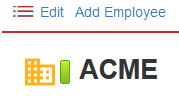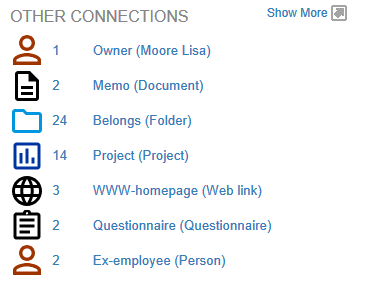Using Summary View
 Main Object Icons
Main Object Icons
A large icon A large icon in the upper left corner of an object's view reminds you of the type of the object. in the upper left corner of the view reminds you of the type of the object All information in Vine is stored in the server database as named objects of different types. Examples: a company, a person, an event, a sales case.. You can drag an object by dragging this icon or right-click it to get object context menu.
 List Object Icons
List Object Icons
In lists In lists objects are represented by small icons and object names. Icons help you to recognize object types. Press a keyboard character (a letter or a digit) to jump to the list item that starts from this character. The first matching item will be chosen, counting from the top of the list., objects are represented by small icons A small object icon represents an object's type in lists..
Information Pane Icons
The top Information pane can include a number of icons telling you about the current status of the object:
|
|
You may see this icon when Vine is not connected Vine objects are linked to each other by connections. Vine shows an object together with links to all objects directly connected to it. to the server and you open an object that you haven't previously opened with your current local database Vine for Windows uses a local database located on your computer. It significantly reduces traffic to the server database and permits you to use Vine off-line.. |
|
|
This icon indicates that only you can see or edit the object. |
|
|
This icon indicates that only the group of users that you are a member of can see or edit the object. |
|
|
This icon indicates that you cannot edit the object. |
|
|
This icon signals that the shown event is repeating. |
|
|
This icon signals that the shown event has the Remind option set on. |
Using Command Panel
A summary view can include a list of frequently used commands at the top which you can click to execute:

Using Top Object/Information Pane
The top Information pane shows the basic information about the object. It can optionally include an image illustrating the object.

Figure. Top panel shows main object
-
Phones, e-mails and Web addresses are displayed as links which can be clicked in order to make a phone call, to send an e-mail or to open a Web site, respectively.
-
A double-click inside the pane will open the object’s edit form.
-
A right-click inside the pane will open the context menu for this object.
Using Connected Object Panes
The panes below the main object pane show various groups of objects connected to the main object. An object pane lists objects having connections of the type specified for this pane in the layout file. Connections not available in other panes are listed in the ‘Other Connections’ pane:

Figure 7. The Other Connections pane shows connections of types not present in other panes
Objects Shown in a Pane
Each pane defines two sets of objects: one filtered set shown in the pane and the full set of connected objects shown when the pane is expanded in a table view. The Summary View can filter objects using values of their fields and, in addition, it can show only objects present in the local database.
Formatting Shown Objects
To properly list and format the filtered objects according to the layout file, the Summary View can:
-
Sort objects by their fields;
-
Show fields in columns of specified widths;
-
Show or hide object counts, icons, etc.;
-
Sum up and publish totals for chosen object fields.
Pane Navigation
You can navigate and use objects in Summary View lists similar to objects in standard Vine lists. You can move within one pane or jump from one pane to another using the mouse or keyboard navigation keys. Objects are opened with a double-click and the context menu shows up after a right-click:

Figure. Objects in Summary View lists behave as in standard Vine lists
Enlarge/Shrink Pane Icons
Each pane has an Enlarge icon Object panes have the Enlarge icon in the upper right corner. If you click the Enlarge icon, the pane will take up the whole view area and will switch to the Table view mode which permits to view the pane objects in full detail. ![]() . Click it to view the data of the pane as a table. To return to the normal object view An object view shows object data. An icon in the upper left corner of the view reminds you of the type of the object. A view usually consists of several panes, with one pane showing the object's data and the other panes showing connected objects.ew click the Shrink icon If you are viewing an object's pane data in a table, you can switch back to the normal mode by clicking the Shrink icon in the upper right corner of the view.
. Click it to view the data of the pane as a table. To return to the normal object view An object view shows object data. An icon in the upper left corner of the view reminds you of the type of the object. A view usually consists of several panes, with one pane showing the object's data and the other panes showing connected objects.ew click the Shrink icon If you are viewing an object's pane data in a table, you can switch back to the normal mode by clicking the Shrink icon in the upper right corner of the view. ![]() .
.
Icon Bars highlighting Object Categories
An object can be assigned a color code which makes its icon augmented with color bar everywhere.

A plug-in can assign a color code to an object or the Vine system can be configured so that objects are assigned different colors based on the values of their parameters.
For example, each project phase In Vine Marketing, a phase is an independent stage of a query. It has its operation type and criteria loaded in its Contents field. can be assigned a color code and users will be able to tell a project’s phase by its color:
